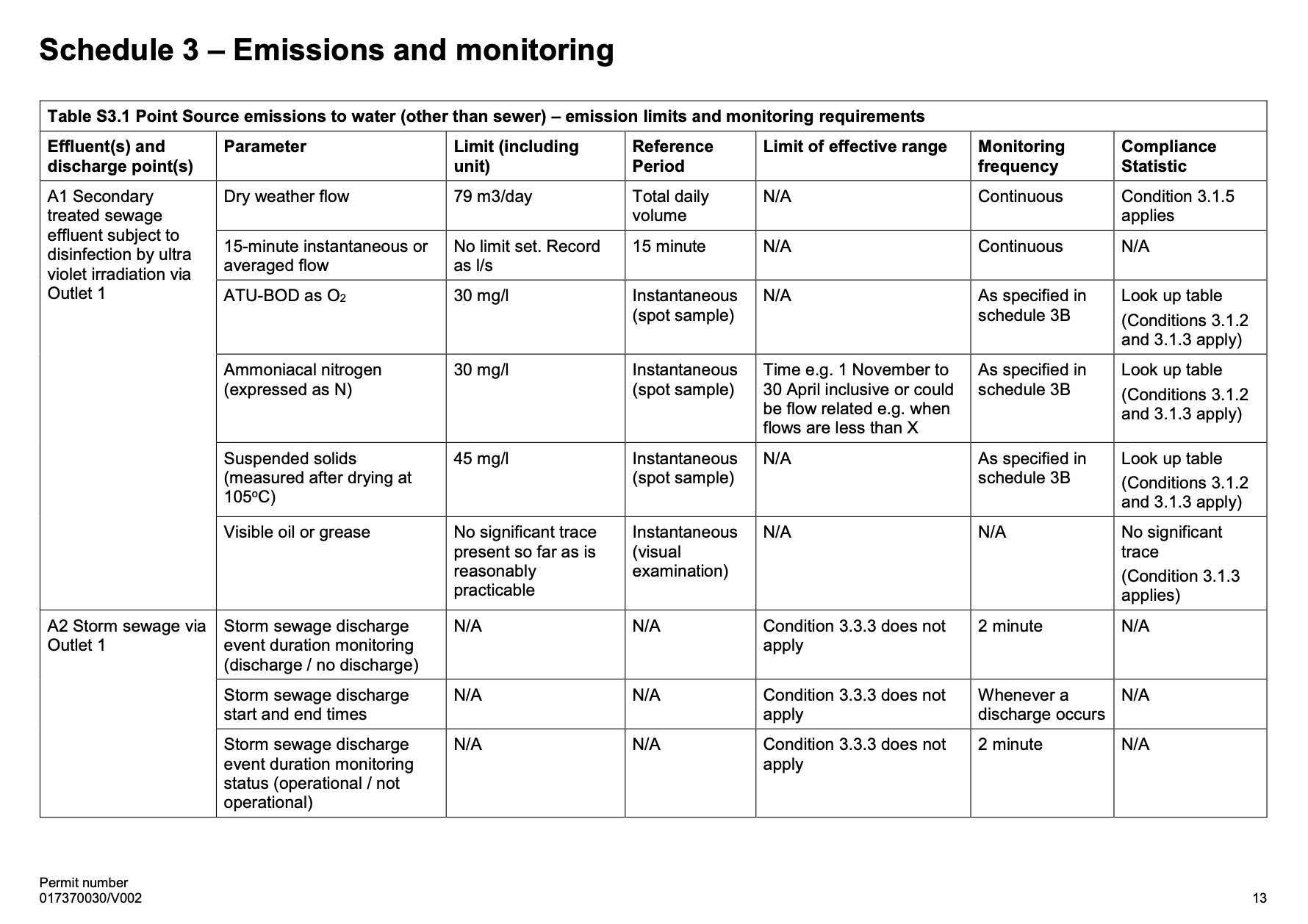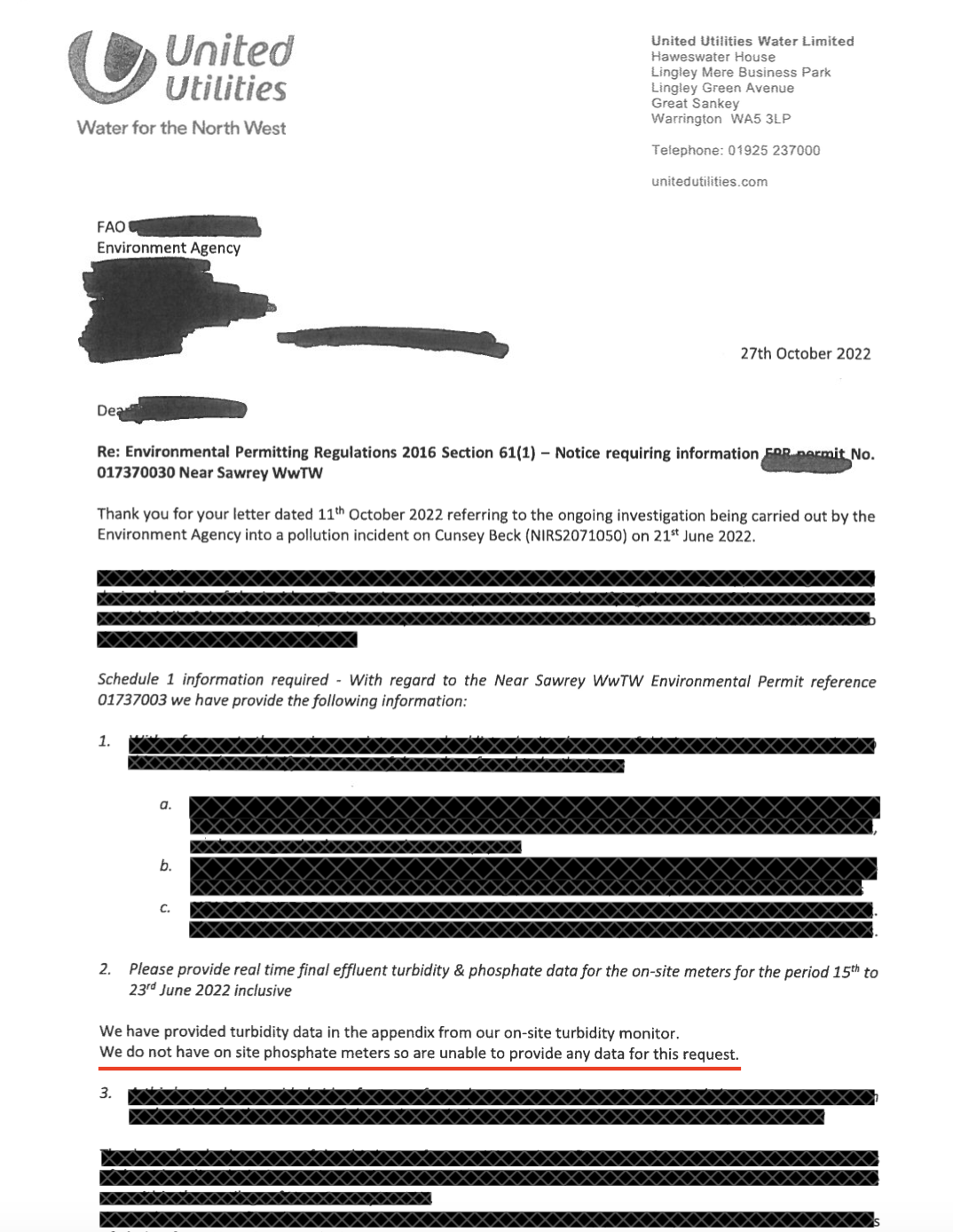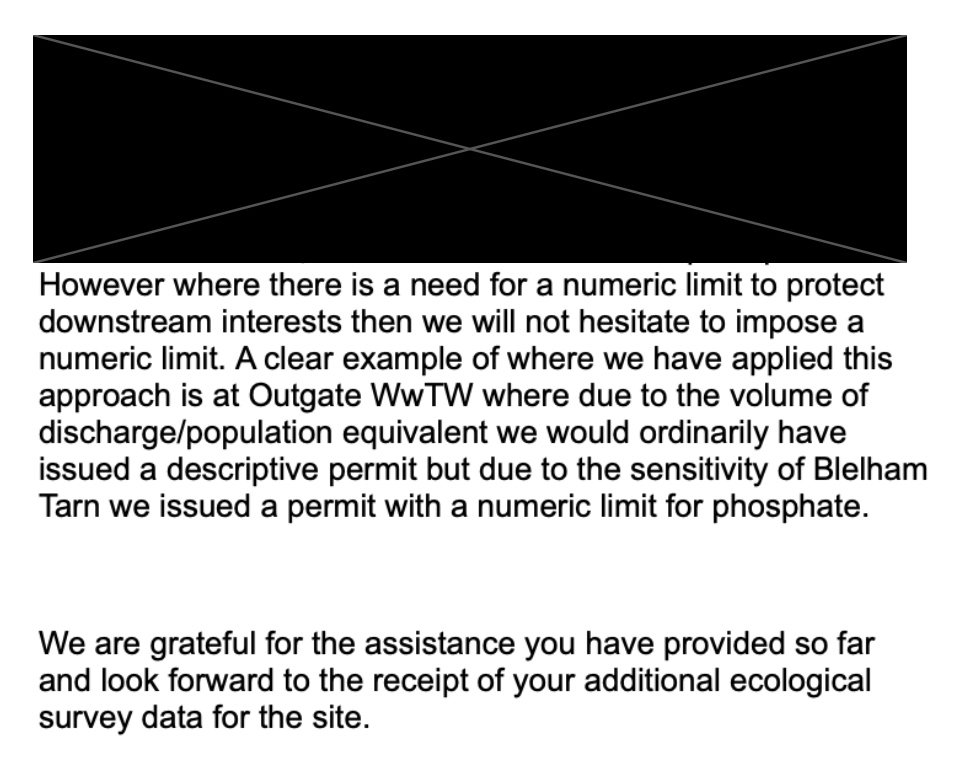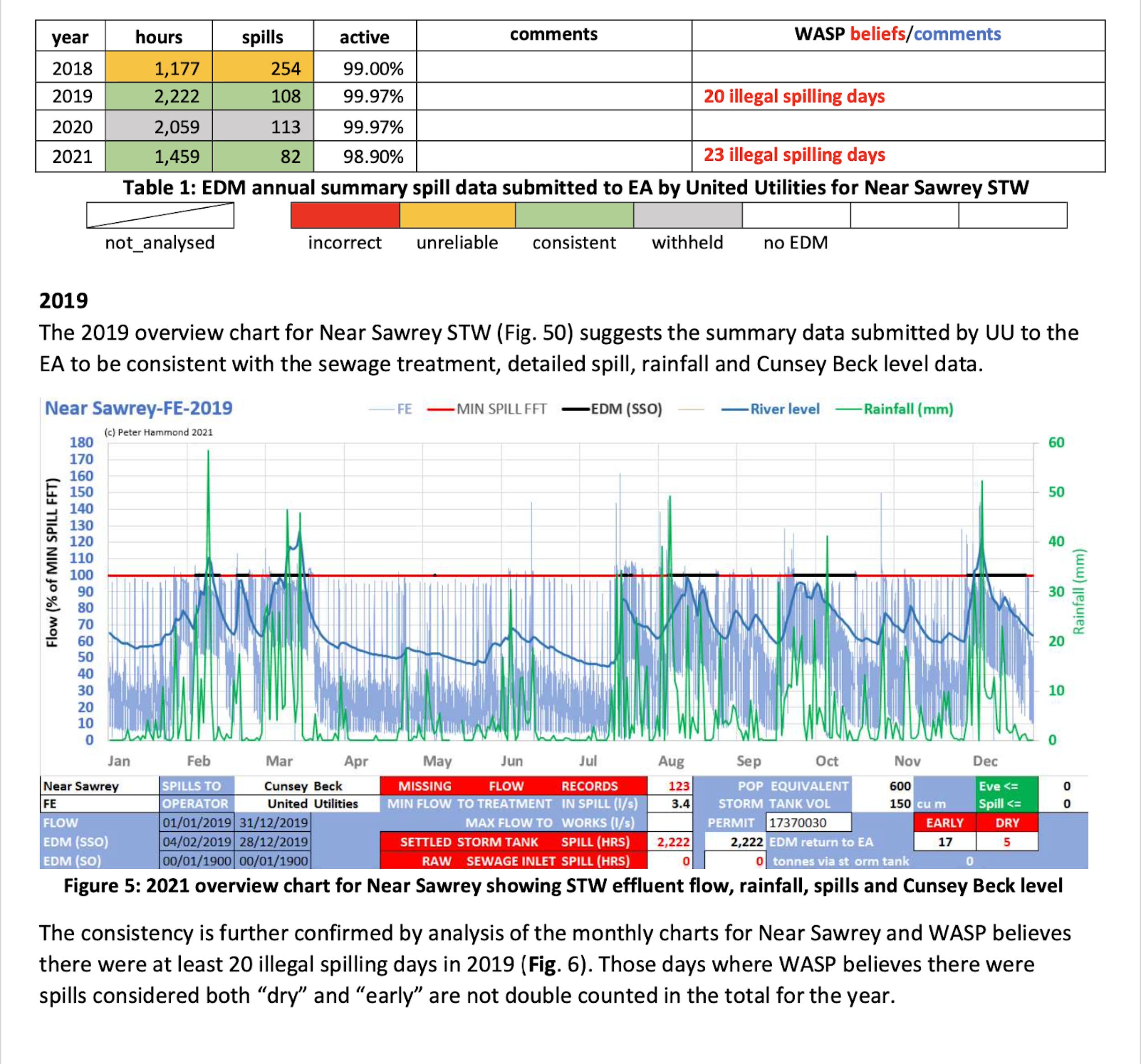EA Permit Review: Analysis of Near Sawrey WwTW in the Windermere Catchment
Executive Summary
No limits set for Phosphorus
Inappropriate limit set for Ammoniacal Nitrogen
33% reduction in total number of pollution sensitive riverfly species downstream from the works vs upstream and a 76% reduction in species abundance
High limit set for Biochemical Oxygen Demand and Suspended Solids
Illegal spilling at the site
EA permitting storm spilling in >0.25mm of rainfall
Save Windermere calls for specific actions
Introduction
Numerical permits are given by the Environment Agency (EA) to United Utilities (UU) to control what can be discharged from their assets. If the limits of these permits are breached then they are breaking the law. But what happens when the permits themselves are not fit for purpose?
As you start reading and digging into the details, you will quickly find issues with these permits. For clarity, this is much more an issue with the EA than UU. It is the EA that provides the water companies with these permits. It's up to them to write them and subsequently enforce them. It is however worth noting that the water companies provide data to the EA when the permits are being reviewed and reset. Research recently undertaken by BBC Panorama for their investigation titled ‘The Water Pollution Cover-Up’ suggests that Operator Self Monitoring data and pollution incident reporting from the water companies can’t always be trusted – so can we trust the data provided when permit reviews occur?
Let's look at Near Sawrey Wastewater Treatment Works (WwTW) as an example of a permit that is not fit for purpose.
Near Sawrey Wastewater Treatment Works (WwTW)
Fig. 1: Location of United Utilities’ Near Sawrey WwTW on Cunsey Beck, just below Esthwaite.
Near Sawrey WwTW discharges directly into a Site of Special Scientific Interest (SSSI). It discharges in the upper reaches of Cunsey Beck which is a 2 mile long tributary that flows from Esthwaite lake to the south basin of Windermere. As well as being a SSSI, Cunsey is home to rare and protected species such as Atlantic salmon, whiteclaw crayfish and European eels.
Due to the significance of the site and the rare species that live there, you would expect the EA permit to be one of the most stringent in the entire catchment, right? Wrong. Not only has the site discharged untreated sewage into the SSSI for 200 days in the last 3 years alone, but, as you will see, to comply with the permit, United Utilities is not required to meet any exceptional criteria when discharging treated sewage into this river. This site has had particular national focus and was most recently featured on the BBC’s Panorama as the EA failed to conduct a systematic scientific investigation to determine the cause of a pollution incident on the beck, which killed 100% of the fish and invertebrate life within the river. In our opinion, Near Sawrey WwTW was the most likely cause.
Below, we will analyse several elements of the Environment Agency’s permit for this site, looking at the different parameters set for monitoring and sampling.
Fig. 2: Environment Agency Permit for Near Sawrey WwTW. Permit number 017370030/V002 obtained via EIR request. Schedule 3 outlines the requirements for emissions and monitoring, with Table S3.1 outlining all emission limits and monitoring requirements for the asset.
Permit Analysis
Phosphorous
The first thing we note when investigating the Near Sawrey permit is a glaring omission. To our surprise, there is no specified limit on phosphorus concentrations from this site, and the Environment Agency seems to be giving it a free pass. The sewage treatment process here relies on a rotating biological contactor (RBC), which we understand can remove some nutrients. However, we were keen to understand just how effective this process is at reducing phosphorus levels. Unfortunately, due to the absence of an EA-mandated limit on phosphorus, there is no requirement for monitoring. This fact was recently confirmed through a section 61 request directed at United Utilities by the Environment Agency (Fig. 3).
Fig. 3: Section 61 request to UU confirming no phosphorous monitoring at Near Sawrey site
The highest phosphorus limit placed on other sites in the catchment is 2 mg/l on average annually (at Langdale WwTW). As a result of this, we have to assume that the site must be discharging at a concentration higher than 2 mg/l on average annually, otherwise we would expect the EA to have placed a limit equal to or lower than this on the site.
To enhance phosphorus removal from the site, United Utilities would need to adopt additional processes such as ferric dosing. This method would facilitate the reduction of phosphorus to a level where its potential harm to the freshwater ecology of this SSSI is significantly reduced.
Now, you might wonder about the rationale behind the Environment Agency's decision to allow an unrestricted release of phosphorus from Near Sawrey. We've taken steps to unravel this mystery by requesting access to the data and correspondence related to the most recent permit review at the site. Our Environmental Information Regulation (EIR) request is in progress, and we eagerly await the information that will shed light on their decision-making process.
A comparison
There are two reasons we feel it’s particularly strange that this site has no limit on the amount of phosphorus coming from it:
Fig. 4: Confirmation from Helen Wakeham on population equivalent criteria for a numeric permit to be required.
Phosphorus from sewage is the primary catalyst for the proliferation of blue-green algal blooms in Windermere, contributing to the deterioration of England's largest lake.
Other sites discharging into SSSI’s in the catchment are subject to restricted phosphorus discharge limits. However, Near Sawrey remains an exception. One facility, in particular, caught our attention: Outgate Wastewater Treatment Works. Outgate's effluent indirectly flows into a SSSI, Blelham Tarn, via a small tributary. As of 2023, Outgate serves a population equivalent to 152 people during peak summer tourism loading. This capacity is somewhat unconventional for the Environment Agency to warrant the imposition of a numerical permit on a site. Typically, such permits are reserved for sites serving populations of 250 or more (Fig. 4). However, Outgate's phosphorus limit is attributed to its discharge ultimately reaching a SSSI (Fig. 5).
So, Outgate WwTW operates under a permit with an annual average phosphorus limit of 2 mg/l. This limit is imposed primarily because of the significance of where its discharge ultimately ends up. Yet, Near Sawrey doesn’t? Near Sawrey’s 2023 summer population equivalent was 210. So not only is the site catering to a larger population load, but it also discharges directly into a SSSI that is in overall ‘poor ecological status’ under the Water Framework Directive (WFD).
Fig. 5: Email from the EA confirming that a phosphorous limit has been issued at Outgate WwTW due to the sensitivity of the receiving water body. Near Sawrey, which discharges into Cunsey Beck, a SSSI, has no limit for phosphorous stated in its permit.
The Environment Agency might attempt to argue that this discrepancy is due to Blelham being classified as having 'moderate' phosphorus status, while Cunsey Beck/Black Beck is designated as 'high' (i.e. good) status for phosphorous. However, there are some critical factors to consider. Cunsey and Black Beck are categorised under the WFD as a single water body, which strikes us as peculiar given their significantly different environmental pressures. Black Beck flows into Esthwaite Lake, while Cunsey exits Esthwaite 1.6 miles downstream, experiencing distinct pressures along the way. Furthermore, there is only one phosphorus sampling site downstream of the WwTW on Cunsey Beck, positioned approximately 2 miles from Near Sawrey WwTW — the sole direct pollution source on the river. The phosphorus sample taken on Black Beck, contributing to the phosphorous classification, is located above all United Utilities assets. Given these circumstances, we contend that Cunsey's classification for phosphorous is misleading and does not accurately represent the varied pressures faced by the two rivers. Our recommendation would be to give the two rivers their own classification, particularly in light of Cunsey Beck’s significance. This would allow for appropriate management and ensure that classifications are not misleading.
In light of Outgate's phosphorus limit, which is justified by its discharge location near a SSSI, we firmly believe that the Environment Agency should impose restrictions on phosphorus levels at Near Sawrey. Our recent invertebrate data, collected both above and below the Wastewater Treatment Works, underscores the chronic and detrimental impact it has on the freshwater ecology of Cunsey Beck.
Invertebrate sampling
We firmly assert that the Near Sawrey permit falls short in safeguarding this Site of Special Scientific Interest, given the WwTW’s demonstrable adverse impact on freshwater ecology.
In collaboration with our partners at WildFish, our Spring and Autumn 2023 invertebrate sampling, conducted in accordance with Environment Agency protocols, paints a concerning picture.
Fig. 6: Sampling sites on Cunsey Beck for spring and autumn invertebrate sampling.
Our kick-sweep sampling was undertaken by an independent ecologist, Dr Nick Everall. Dr Everall is the Director of Aquascience Consultancy Ltd. and the former head biologist at Severn Trent Water, with over 30 years experience in the water industry, wetland operational science, environmental monitoring and watercourse catchment management.
Invertebrate populations were relatively low across the Cunsey Beck sites, but what was particularly apparent is the consistent community decline across seasons immediately below the works. Downstream from the Near Sawrey wastewater treatment works, there is an average 33% reduction in the total number of pollution-sensitive riverfly species compared to upstream locations with comparable river habitats. Furthermore, our annual data highlights a substantial 76% decrease in riverfly species abundance downstream, again in comparison to upstream habitats of similar nature. These reductions in riverfly species, recognised as potent biological indicators sensitive to environmental shifts, particularly in pollution levels, raise profound concerns. Often likened to 'canaries in the coal mines,' they serve as early warning signs of environmental distress and deterioration. The data strongly suggests that the Near Sawrey site is significantly and detrimentally impacting the freshwater ecology of Cunsey Beck.
Fig. 7: Phosphorous stress exhibited by the invertebrate communities at the Cunsey Beck SmartRivers sites in spring and autumn 2023.
In addition to chemical, sediment, and organic signatures, the invertebrate community displays an increasingly negative biological signature of phosphorus, as evidenced by the Total Reactive Phosphorus Index (TRPI) downstream of the sewage works, likely due to input from the site (Fig. 7). This underscores the urgent need for strict limits on permitted phosphorus levels emanating from Near Sawrey WwTW into Cunsey Beck. Read more on TRPI and the methodology used here.
So, what invertebrate sampling efforts has the Agency been carrying out on Cunsey Beck to better understand the impact on these 'canaries in the coal mine'? A comprehensive, independent review of the Environment Agency's Catchment Explorer reveals a striking absence of any invertebrate sampling on Cunsey Beck under the WFD since 2014. For over a decade, the EA has not published invertebrate data for Cunsey Beck, despite recent discussions within the Agency about the necessity for invertebrate sampling to address the water body's persistent failure in achieving its WFD classification, as detailed in the EA's ecology report dated 23/06/22 (Fig. 8).
The glaring question that arises is why this critical data has not been uploaded to their Catchment Explorer? Has this data not been utilised in the WFD classification assessment of Cunsey Beck, and if not, why? Most importantly, where is this data now?
Fig. 8: Excerpt from EA Ecology Report for Cunsey Beck dated 23/06/22 suggesting invertebrate sampling should be conducted on the beck. No data from this sampling has been published.
Invertebrate sampling was conducted on Black Beck in 2022, once again reaffirming that classifying both of these rivers together is skewing the results and is hiding the ecological damage that is occurring on Cunsey Beck. In the last year alone, we have demonstrated that it is not only acute incidents that cause issues, but more concerningly there is a long-term chronic decline of this significant habitat, which is reflective of long-term mismanagement.
Ammoniacal Nitrogen
The next parameter of the permit that we are most concerned to see is the one established for Ammoniacal Nitrogen. Elevated levels of ammoniacal nitrogen in the environment can lead to dire consequences, especially if it results in increased unionised ammonia during dry conditions. To illustrate the gravity of this issue, consider two instances: the River Wye at High Wycombe and the River Cherwell. The River Wye, a rare chalk river, witnessed a catastrophic fish kill due to ammonia levels exceeding 20 mg/l, while a similar tragedy occurred on the River Cherwell due to similarly high ammonia concentrations. Neither of these incidents resulted in prosecution, as both fell within the limits stipulated by the Environment Agency permits. Discharge limits must be tightened to prevent these fish kills from being ‘permitted’ and allow for prosecution.
Now, let's shift our focus back to Near Sawrey. If a small river like Cunsey Beck sees temperature fluctuations, pH changes, and elevated ammoniacal nitrogen levels, particularly during low flow conditions, this could be disastrous and see the death of thousands of fish! One would expect stringent limits to protect this ecologically significant location. However, the Environment Agency has set the ammoniacal nitrogen limit at 30 mg/l!
We decided to compare this limit with those imposed in other areas of the country and consulted Windrush Against Sewage Pollution (WASP) for insights. WASP suggests that this limit is more reflective of the wastewater treatment works' capacity rather than the condition of the receiving watercourse, which, as a reminder, is designated as a Site of Special Scientific Interest. WASP states:
“An Ammoniacal nitrogen level of 30mg/l is ridiculously high and particularly given the SSSI status of the receiving water body. Please find the attached spreadsheet within which you will find included all the emission limits for Thames Water Utilities Ltd’s WWTWs. For NH3 [ammoniacal nitrogen] there is just one site with a 45mg/l permit level, one at 30mg/l, followed by 12 at 20mg/l. The remaining 222 permit limits are 18mg/l and lower with 84 of these 3mg/l or lower.”
WASP also highlights a statement made by Severn Trent Water following a WwtW upgrade. They state:
“The new standards imposed by the Environment Agency, in accordance with the European Water Framework Directive, lay down a minimum level of 3mg/l as a 95th percentile standard.”
So why is the North West Environment Agency not imposing these same standards, especially in a protected area? If 3mg/l of Ammonical Nitrogen is the acceptable limit, one can only imagine what discharges at 30mg/l would do to a small river in a drought.
Following the fish kill in 2022, Cunsey Beck is evidently under severe amounts of pressure. As our climate changes, permits like this belong in the dark ages and act as yet another example of EA complacency to protect our environment.
An incomplete permit?
Another concerning aspect, that suggests a lack of care from the EA, is found when examining the 'limit of effective range' for Ammoniacal Nitrogen in the permit, as it states:
“Time e.g. 1 November to 30 April inclusive or could be flow-related, e.g. when flows are less than X.”
We meticulously reviewed this permit and nowhere could we find any definition of ‘X’ in relation to flows. Nor could we find any reference to a specified time period. Therefore, we believe this permit is incomplete as these parameters have not been defined – a blatant example of the EA's complacency or incompetence. As highlighted below this is not common practice in discharge permits across the nation (Fig. 9).
Fig. 9: Comparison of Ammoniacal Nitrogen limits in EA permits for Near Sawrey and Witney WwTW, noting incomplete parameters for Near Sawrey in the ‘Limit of effective range’ field.
Suspended Solids
High total suspended solids (TSS) in drinking water or wastewater can have both environmental effects and effects on human health. When it comes to water quality, high TSS may decrease water's natural dissolved oxygen levels and increase water temperature.
The limit for suspended solids set at Near Sawrey (45 mg/l) is high, but is not unusual. What raises concern, however, is that when elevated levels of suspended solids are permitted and subsequently discharged, it can have a cascade of detrimental effects on watercourses. This includes a reduction in dissolved oxygen levels, the obstruction of sunlight penetration, and the inhibition of photosynthesis.
Fig. 10: Sediment stress exhibited by the invertebrate communities at Cunsey Beck SmartRivers sites in spring and autumn 2023.
Our invertebrate sampling identified a substantial siltation pressure across both sample seasons at the site just below Near Sawrey WwTW (Fig. 10). Sediment build-up alters the composition of the river’s substrate making it uninhabitable for invertebrates, by destroying refugia and impacting their ability to forage or find shelter. Increased siltation can also cause physical damage through abrasion or fill clogging. Siltation pressure significantly declined at the site further downstream from the works, reflected in the presence of numerous siltation sensitive caddisflies.
Cunsey Beck, at the point where it receives this discharge, measures approximately 12 metres in width, making it one of the smaller tributaries feeding into Windermere. Given this, we wouldn't typically expect to see such a high concentration if the nature of the receiving water course had been adequately considered when the permit was applied for.
Furthermore, it's worth noting how discharges with high suspended solids can affect UV disinfectant treatment. The UV bulbs used in such treatment processes can reach high temperatures, which can result in organic matter adhering to the bulbs, impeding their ability to effectively remove bacteria. While we cannot confirm if this issue is occurring at Near Sawrey, we strongly advocate for a more comprehensive examination of the UV treatment processes at the site, especially in light of the high levels of permitted suspended solids in the discharge.
Biochemical Oxygen Demand (BOD)
To provide some context on this parameter, the greater the BOD, the more rapidly oxygen is depleted in the stream. This means less oxygen is available to higher forms of aquatic life. The consequences of high BOD are the same as those for low dissolved oxygen: aquatic organisms become stressed, suffocate and die.
The BOD permit limit (30 mg/l) is again high but not unusual; however, WASP provides another useful point of view:
“Find attached a quote from WTE Treatment Systems: ‘Normal domestic sewage generally has a BOD of between 250 and 400mg/l. This is much too high and sewage treatment must reduce it to a maximum of 20mg/l in the UK to minimise pollution potential. The Environment Agency may require sensitive sites to achieve even lower levels.’ Again this does imply that the Near Sawrey permit limit is far too high.”
This is just one more compelling example of why we believe this permit is fundamentally inadequate, especially considering that it allows for direct discharge into a Site of Special Scientific Interest (SSSI), and there is clear evidence of its detrimental impact on the freshwater ecology of the river.
Storm Spilling and Illegality
This site is also a big spiller. In fact, it ranks among the highest spillers in the entire catchment. Since 2020, it has released untreated sewage into Cunsey Beck for a staggering 4,823 hours, which is equivalent to 200 full 24-hour days in just 3 years. This data is recorded by United Utilities’ event duration monitor and is supplied on a yearly basis to the Environment Agency.
What's even more alarming is that this site has a history of illegal spills dating back to at least 2018, a fact we can confidently assert thanks to the diligent work of Professor Peter Hammond of Windrush Against Sewage Pollution. Analysis from 2019 is shown below as an example (Fig. 11). Interestingly this site spills illegally despite the storm tank at Near Sawrey being six times larger than the EA requirement and the WwTW’s capacity being approximately 7 times the dry weather flow (rather than the standard 3).
Fig. 11: Example of analysis conducted by WASP to demonstrate illegality at Near Sawrey.
It's worth noting that illegal spills indicate a lack of capacity, and investment to bring sites up to capacity cannot fall within the next asset management (AMP) cycle. The cost of such improvements must be borne by the water company and not passed on to the bill payer, given that consumers have already paid for a service that has not been provided. United Utilities is set to invest in storm overflow reduction at this site, but has not quantified anywhere how much of that investment will be going towards bringing this site up to compliance. Any investment to compliance cannot fall within AMP 8.
When it comes to illegality at these sites, UU has stated that either the data is incorrect or the analysis is. The data used to determine the illegality is UU’s own data provided to the EA and obtained by Save Windermere or WASP via EIR request. The site has both MCERTS flow meters (EA accredited flow meters) and an event duration monitor, so the likelihood is that this data is accurate. When it comes to the analysis, Professor Hammond's work has exposed illegality nationwide and even the big boys like Thames Water and Welsh Water are not arguing with his analysis. In fact, following Hammond’s analysis of Welsh Water data which exposed illegality, Steve Wilson, the Managing Director, stated: "We're not proud of this at all. It's a very uncomfortable position to be in - but it's not for the want of trying. We have been trying to fix this."
Near Sawrey is not the only site where Professor Hammond has identified instances of illegality. Similar issues have been identified at Grasmere, Ambleside, and Hawkshead pumping stations [read our blog on illegality here].
Exceptional Circumstances
We also benefit from the expertise of our partners at WildFish, who took the UK government to court in June of this year. This legal action resulted in some significant findings, most notably that the government and, consequently, the regulator must enforce the 1994 regulations outlined in the Urban Wastewater Directive. The crux of this regulation is the stipulation that untreated sewage should only be discharged into our lakes and rivers in 'exceptional circumstances.' In fact, the UK government was previously taken to court by the European Commission in 2012, leading to the determination that the majority of sewage spills in the UK were unlawful because they were not occurring in truly exceptional or unforeseeable events. To clarify, 'unforeseeable' means events that cannot be predicted.
One might reasonably expect that such a definition of the law would be incorporated into the Environment Agency permits governing discharges in and around England's largest lake, situated within a national park. However, this assumption would be incorrect. Surprisingly, storm-spilling during rainfall or snowmelt is permitted at Near Sawrey (Fig. 12). And it’s not alone. Other UU assets, including Ambleside WwTW, Elterwater PS, Grasmere WwTW, Hawkshead PS, and Glebe Road PS, all of which discharge untreated sewage, have similar allowances in their permits that allow discharges due to rainfall or snowmelt.
Fig. 12 & 13: EA Permit for Near Sawrey showing conditions for discharge; and excerpt from Compliance Assessment Report stating the site is allowed to spill in >0.25mm of rain or snow melt.
Now, Near Sawrey's population equivalent (PE) falls slightly below what one might expect to trigger the ‘exceptional circumstances’ rule. However, as we've emphasised repeatedly, this site discharges into a Site of Special Scientific Interest (SSSI), which represents some of the most crucial habitat in the UK. If there's any place where the rule should apply, it's Cunsey Beck.
The specific rainfall threshold required for discharge at Near Sawrey is actually documented in a recent compliance assessment report (Fig. 13). According to this report, Near Sawrey can spill after just >0.25mm of rainfall or snowmelt in the previous 24 hours. Yes, you read that correctly.
Untreated sewage can be discharged into the lakes and rivers of the Windermere catchment, and in many cases, arguably unlawfully, because the regulator permits United Utilities to do so. It's worth noting that this threshold is not explicitly stated within the permit, and it raises a critical question: Does this seem 'exceptional' to you?
Withholding of Data
There may be even more to uncover when it comes to this site and our efforts to build a picture of what is truly happening here continue to be hampered as United Utilities withhold data and obfuscate.
Save Windermere, WildFish and Windrush Against Sewage Pollution have all had data withheld when asking questions about Windermere.
Conclusion
We hope that you can see, even from our examination of this single permit in the Windermere catchment, that the Environment Agency is not doing enough to protect Windermere and the lakes and rivers that feed into it. What we see here is a troubling level of complacency, resulting in the exploitation of our precious lake. We've submitted Environmental Information Regulation (EIR) requests to the Agency, and the information we obtain through these requests may shed further light on why this permit has been structured as it is.
The remedies for this situation are straightforward, and the Agency could take immediate action to ensure that the Near Sawrey site ceases to harm Cunsey Beck and Windermere. However, if their recent refusal to reopen the Cunsey Beck fish kill investigation is any indication, they will continue to be an ineffective regulator, failing to meet the needs of this National Park. We will provide updates as we receive responses to our EIR requests and as we continue to engage directly with the Agency and other stakeholders. Once again, the Environment Agency is failing to protect Windermere.
Our Demands
We demand that the Environment Agency, without delay, reviews the permit for Near Sawrey WwTW in the first quarter of 2024.
The Agency must prosecute for the illegality demonstrated at the site.
The change in permit must make an exception at Near Sawrey so untreated storm discharging should only occur in exceptional circumstances or not at all.
Discharge limits must be tightened to reduce the adverse impact on the freshwater ecology of Cunsey. This includes phosphorus limits, and the restricting of suspended solids and ammoniacal nitrogen from the site. This must include all parameters being monitored actively from the site.
We demand that the Environment Agency, in light of the recent Panorama exposé, reopens the investigation into the Cunsey Beck fish kill that occurred in June of 2022.
We demand that United Utilities install real-time nutrient monitors on all inflows and outflows from the site. This is to include real-time untreated spills as well as real-time nutrient concentrations of all final treated effluent.
United Utilities must look at how they can include additional treatment at the site and also model how they would completely remove the site from discharging into the SSSI by diverting the flow to a larger site or out of the catchment in its entirety.
Any ambiguity / incomplete elements within the permit must be clarified and enforced.













